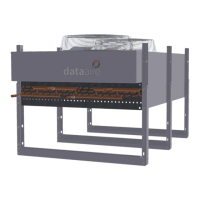6 • Air Cooled Condenser User Manual
NOTE: It is the responsibility of the installing contractor to return the start-up sheet and
warranty registration card to Data Aire for proper activation of the unit warranty. Failure
to do so may cause delays and in some cases void the warranty.
WARNING: This equipment may contain substance that has been deemed harmful
to public health and the environment. Venting of refrigerants to the atmosphere is
illegal. Refrigerant recovery devices must be used when installing and/or servicing
these types of products.
1.4 Storage
Data Aire equipment comes ready for immediate installation. However, in some instances, it may
be necessary to store the equipment for a period of time. If you must store the equipment it should
be done in a dry area, out of the weather, protected from freezing temperatures, protected from
damage by other equipment in storage, or transportation equipment. Avoid stacking and frequent
relocation.
If equipment is stored for longer than 30 days special precautions must be taken to avoid coil dam-
age. All coils should be charged and sealed with a low pressure (less the 25 PSIG) inert gas, such
nitrogen. This prevents contaminants from entering the coils. When the seal is broken at installa-
tion, the rush of escaping gas veries the coil is still leak free. If coils are not charged and sealed,
condensation mixes with air pollutants forming a weak acid and over time can cause pinhole leaks
to develop in coil tubes.
When equipment is installed after storage, caution should be taken to inspect and replace damaged
components, if required. All moving parts should be hand tested to ensure they are free and clear
prior to start-up.
1.5 Locating the remote heat exchanger
Remote air-cooled condensers (i.e., heat exchangers) should be located in secure areas where
service is easily accessible. Areas where public access is available should be avoided. Avoid areas
that contribute to ice and snow accumulation. The condenser may need to be elevated to ensure it is
above the snow line in certain regions of the country. Condensers should be located in clean areas
free from debris or foreign matter that could block the coil surface. Avoid areas of hot air or fume
exhaust. Condensers should not be located near steam vents.
Figure 1

